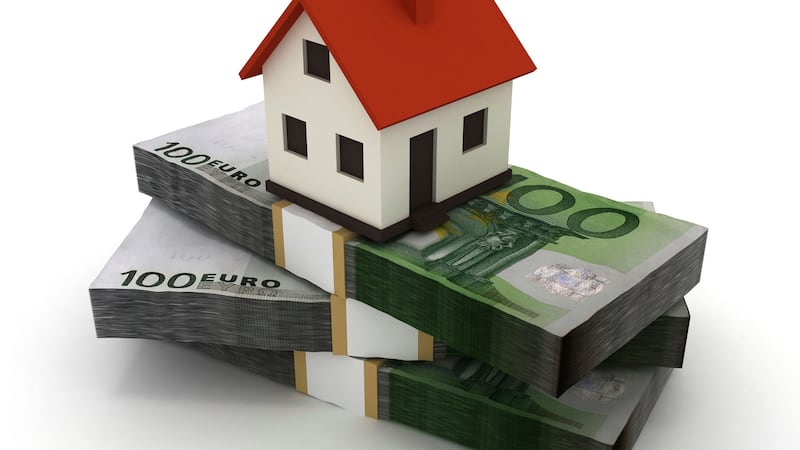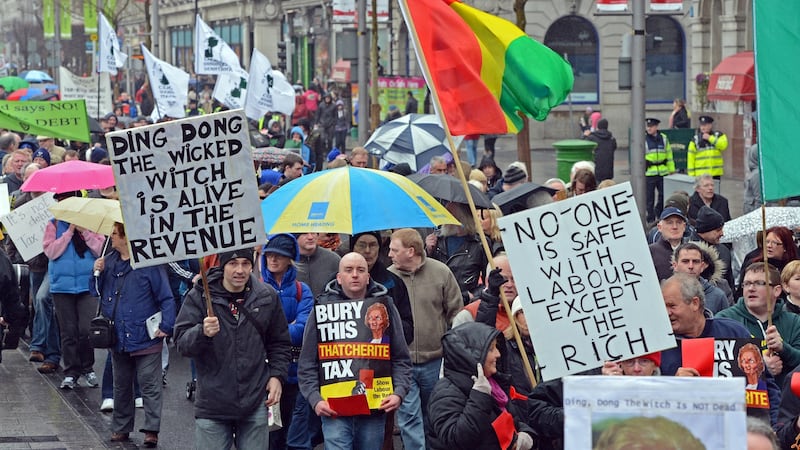Taoiseach Leo Varadkar and Fianna Fáil leader Micheál Martin met on Thursday to discuss the general election date.
As part of any deal to extent the current term, Varadkar is seeking agreement from Martin on reform of the local property tax. This looks unlikely, as any likely change will lead to some householders paying more next year.
Fianna Fáil will surely ask why they should be signing off on this unpopular move – even if there are some households, too, which will save money. Here is why this is so tricky and why solving the local property tax conundrum has implications for our pockets, not only next year but beyond.
1. The problem
Making a decision on what to do with the local property tax has been ducked by this Government and its predecessor, now storing up quite a tricky issue. The tax was introduced in 2013, when the exchequer was deep in the red, to raise revenue but also to widen the tax base.
The intention was that the house valuations on which the tax is based would be revised in late 2016, leading to adjusted bills in 2017. But faced by rising property prices, then minister for finance Michael Noonan announced a postponement until November 2019. Following an inter-departmental report, current Minister for Finance Paschal Donohoe announced a further delay in the revaluation date until November of this year, which would – were it to go ahead with no other changes – lead to higher bills in 2021.
The big increase in property prices since 2013 means allowing the bills to be set solely on the basis of current house valuations would lead to large increases for many. For example, last year’s interdepartmental report calculated that more than half the liable houses would face an increase of between €100 and €300 per annum. A small group of around 12 per cent of higher-priced houses, largely in Dublin and its south suburbs, would face rises of more than €500, generally doubling existing bills.
Donohoe has made clear that this won’t happen. But the key issue is that finding a way to restructure the tax is not straightforward. If you want to keep the same level of revenue, then whatever option is chosen, some households will lose, and some will win.
This is because house price increases since 2013 have varied across the country, so there is no one formula which will leave everyone paying exactly the same. This is why Fine Gael wants Fianna Fáil to sign up for a deal on this – and why Fianna Fáil will surely be loath to do so.

2. Inaction not an option
Not acting is not an option either, at least in the next few years. The Government has been warned that the way the tax now works and the exemption for any new property built since 2013 – or any house purchased in 2013 – could leave it open to challenge on the basis of fairness. Leaving a property tax based on valuations from years ago interminably is clearly not an option. The former system of domestic rates collapsed partly due to losing credibility over valuations.
Now, advice from the Attorney General has even questioned the legal basis for extending the deadline past November. So whoever is in government after the election will have to make a call on this, and quickly. It is likely that the two main parties will try to get through the election promising to change people’s bills as little as possible, but not outlining exactly how this would be achieved.
3. The reform menu
The problem with tinkering with the tax is twofold. First, it is inevitable, unless the government accepts a much lower amount of revenue, that some will gain and some will lose in 2021 from any reform, even if the changes will be small enough in many cases.
Second, to be credible a reform plan must outline the future of the tax – in other words, will it rise and fall with house prices, local authority needs or what in the years ahead?
The inter-departmental group came up with a range of options involving changes to the rate the tax is charged at and – in one option – the house price bands which determine who pays what. At the moment the rate is 0.18 per cent on houses valued up to €1 million – within various bands – and 0.25 per cent on the amount over €1 million.
It is likely that any reform will involve a lower rate – one option, outlined as scenario one, was a straight cut in the rate to 0.114 per cent. But this led to significant pluses and minuses for various households – and so other scenarios were examined.

It is possible to reduce the changes from current property tax bills by introducing different, lower, rates in different local authorities, based on what is needed to maintain their own revenue from the tax. This was known in the document as scenario two. This would mean potentially 31 different rates for the tax.
Another scenario examined – involving different rates in each local authority and different rates for every value band – would mean potentially 620 different rates. This was known as scenario three.
This would be too complex and anyhow could have all kind of odd consequences in the long term. But it does highlight the central issue – the more you try to ensure that people’s bills say as close as possible to current levels, the more complex the new system would look. And in turn, as the report said, this might only be storing problems up for the future.

4. Who might pay more - and less?
This will depend, of course, on what option is chosen. But the political issue is that any option will create different groups of winners, and more awkwardly, losers. And while the average change will be small in most cases, a significant minority of households would face increases of €150 or more in their annual bill under many of the options chosen.
In broad terms one group that is vulnerable are those with the cheapest houses currently valued at less than €100,000 – almost all in rural Ireland – as the step up is greater moving into the next band up. So if scenario one were chosen, involving just a cut in the rate, someone whose house passed the €100,000 threshold could see their bill rise by €53.
At the far end of the spectrum, some owners of expensive houses, notably in Dublin and its southern fringes, could see significant increases, in some cases of €150-€200 or more, as the cut in the rate does not entirely make up for their above average house price increase since 2013.
The different scenarios predictably lead to different results. In scenario three, for example – the most complicated one involving potentially different rates in each band in each local authority area – around one-third of houses would face a change.
Of these, a quarter of households would face rises of between €50 and €100 a year – mainly houses outside Dublin in the €200,000 to €250,000 area while another one in five in more expensive homes face rises of €101 to €150. Around 8 per cent of the houses affected – about 50,000 households mainly more in expensive parts of Dublin – would face rises of €200 or more.
In scenario two, almost one in five houses would see a rise of €50 or more in their annual bill, though fewer would be hit be €200 plus rises. So now we are starting to understand why this is politically sensitive.
Another way of looking at it is to look at the average house in each local authority area (see table, which looks at the impact on an average house in each area under the three scenarios).
The impact varies significantly – but the hit to some urban areas is evident, as is the fact that some poorer areas face an increase too, partly because of lower valued homes making the jump to the second band. Many of the “winners” are in the middle ground where the lower rate – or rates – can often offset the rise in house prices.
Another option considered was a sharp widening of the bands and some adjustment here could come back into the frame.
Remember, too, that around 25,000 houses – houses sold in 2013 or any new house bought since then – are currently exempt and will probably be brought into the net. So there is a group facing payment of the tax for the first time.
But the political issue is clear. Setting the tax on the basis of current valuations but making no other change can’t happen. But any adjustment, while leaving many unaffected, also has significant numbers of losers and a small number who would pay significant more.
5. The politics
The politics of this suggest that no deal will be done ahead of a general election and that the two main parties, while pledging that the tax will continue, will try to avoid getting into detail. Sinn Féin has opposed the tax – despite residential property being the main source of personal wealth, it says it is unfair and can penalise people on low incomes.
But after the election there are some key decisions to be made. These include not only which reform plan to choose, but also what signal to send for the future.
The review group recommended houses be revalued every four years. A call also needs to be made on whether new homes bought since 2013 are included – probably yes, on fairness grounds. And then there are decisions on the current system of local authority funding under which better off local authorities subsidise less well-off ones, which is controversial in the city councils.
This could be changed, but in some scenarios these would lead to the exchequer paying more.
These are all tricky decisions, but it is surely impossible that the can will be kicked down the road again at the end of this year. Or maybe it isn’t. What’s another year?











